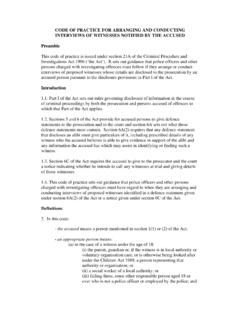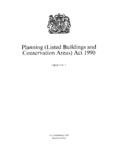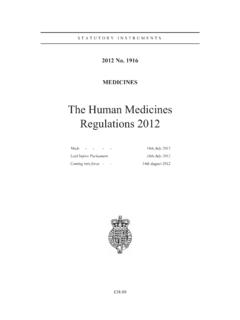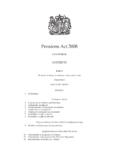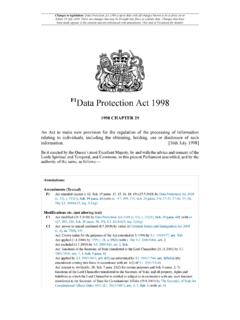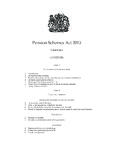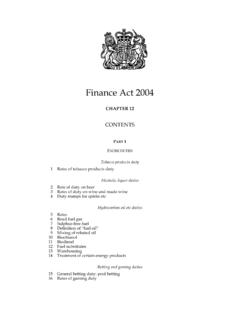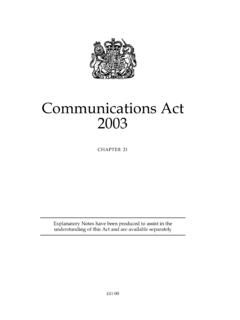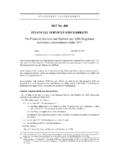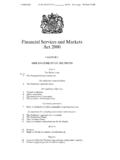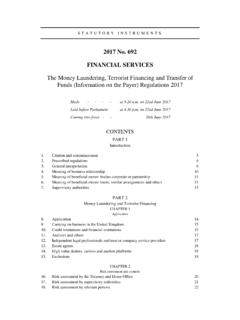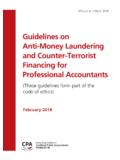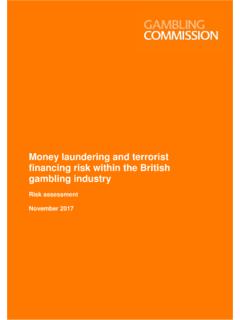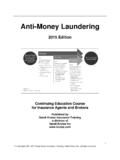Transcription of The Money Laundering, Terrorist Financing and …
1 TNA/ 1 EXPLANATORY MEMORANDUM TO THE Money laundering , Terrorist Financing AND transfer OF FUNDS (INFORMATION ON THE PAYER) REGULATIONS 2017 2017 No. 692 1. Introduction This explanatory memorandum has been prepared by HM Treasury and is laid before Parliament by Command of Her Majesty. This memorandum contains information for the Joint Committee on Statutory Instruments. 2. Purpose of the instrument These Regulations replace the Money laundering Regulations 2007 and the transfer of Funds (Information on the Payer) Regulations 2007 with updated provisions that implement in part the Fourth Money laundering Directive (4 MLD or the Directive ) 2015/849/EU and the Funds transfer Regulation (FTR) 2015/847/EU.
2 4 MLD seeks to give effect to the updated Financial Action Task Force (FATF) global standards which promote effective implementation of legal, regulatory and operational measures for combating Money laundering , Terrorist Financing and other related threats to the integrity of the international financial system. 3. Matters of special interest to Parliament Matters of special interest to the Joint Committee on Statutory Instruments The Regulations come into force in national law on 26 June as this is the transposition and implementation date in the Directive and FTR.
3 This means that the 21 day rule will be broken in order to meet the transposition deadline. Due the dissolution of Parliament for the General Election which was held on 8 June, and the need for new ministers to approve the Regulations it has not been possible to lay these Regulations any earlier. 4 MLD will be transposed into UK law through the Money laundering , Terrorist Financing and transfer of Funds (Information on the Payer) Regulations 2017 ( the Regulations ). The FTR works in conjunction with 4 MLD.
4 Unlike 4 MLD, the FTR does not need to be transposed because it has direct effect from 26 June 2017. However, the powers to supervise, enforce and investigate breaches of the FTR, as well as related regulations such as setting thresholds for customer due diligence and increased data retention periods to assist with law enforcement investigations, will be included in the MLRs. Other matters of interest to the House of Commons As this instrument is subject to negative resolution procedure and has not been prayed against, consideration as to whether there are other matters of interest to the House of Commons do not arise at this stage.
5 TNA/ 24. Legislative Context These Regulations introduce a number of new requirements on relevant businesses and changes to some of the obligations found under the current regime. In addition, the new FTR accompanies the Directive and will come in to force alongside the Directive in all EU Member States. It updates the rules on information on payers and payees, accompanying transfer of funds, in any currency, for the purposes of preventing, detecting and investigating Money laundering and Terrorist Financing , where at least one of the payment service providers involved in the transfer of funds is established in the EU.
6 Provision for anti- Money laundering and counter- Terrorist Financing controls is also made under the Proceeds of Crime Act 2002 and the Terrorism Act 2000. New provision relevant to information on beneficial ownership of legal entities is also being made by the Information about People with Significant Control (Amendment) Regulations 2017 and the Scottish Partnerships (Register of People with Significant Control) Regulations 2017, which are being laid at the same time as these Regulations. There was full scrutiny of 4 MLD before it was finalised in June 2015.
7 5. Extent and Territorial Application The territorial application of this instrument is all of the United Kingdom. This instrument extends to all of the United Kingdom. 6. European Convention on Human Rights The Economic Secretary to the Treasury, Stephen Barclay MP, has made the following statement regarding Human Rights: In my view the provisions of The Money laundering , Terrorist Financing and transfer of Funds (Information on the Payer) Regulations 2017 are compatible with the Convention rights. 7. Policy background What is being done and why The principal policy objective behind 4 MLD is to update and enhance European legislation to bring it in line with the international standards on combating Money laundering and Terrorist Financing as set out in the revision to the FATF standards in 2012.
8 Consequently, the Regulations are underpinned by the principles of effectiveness and proportionality as well as continuing the focus on a risk-based approach. The UK government s objective, through transposing 4 MLD, is to make the financial system a hostile environment for illicit finance while minimising the burden on legitimate businesses. Alternatives to the Regulations are not available and the UK must transpose 4 MLD into domestic legislation by 26 June 2017 to meet EU obligations. Money laundering can undermine the integrity and stability of our financial markets and institutions.
9 It is a global problem, however, and the UK must play its part in strengthening our regime and working with international partners to tackle Money laundering . The National Crime Agency (NCA) judge that billions of pounds of TNA/ 3suspected proceeds of corruption are laundered through the UK each year. Money laundering is also a key enabler of serious and organised crime, the social and economic costs of which are estimated to be 24 billion a year. There are over 100,000 businesses covered under the Regulations which require that these businesses know their customers and manage their risks.
10 The Regulations are deliberately not prescriptive, providing flexibility in order to promote a proportionate and effective risk-based approach. Scope The Regulations apply to financial institutions, including Money service businesses, and to those sectors that are seen as gatekeepers to the financial system including auditors, legal advisers, insolvency practitioners, external accountants, tax advisers, estate agents, casinos, high value dealers (HVDs) and trust or company service providers (TCSPs). One important change applies to HVDs, where the threshold for eligible transactions in cash (either in one transaction or a series of transactions that appear to be linked) will come down from 12,544 (EUR 15,000) to 8,361 (EUR 10,000); and will be extended to receiving as well as making payments in cash.
